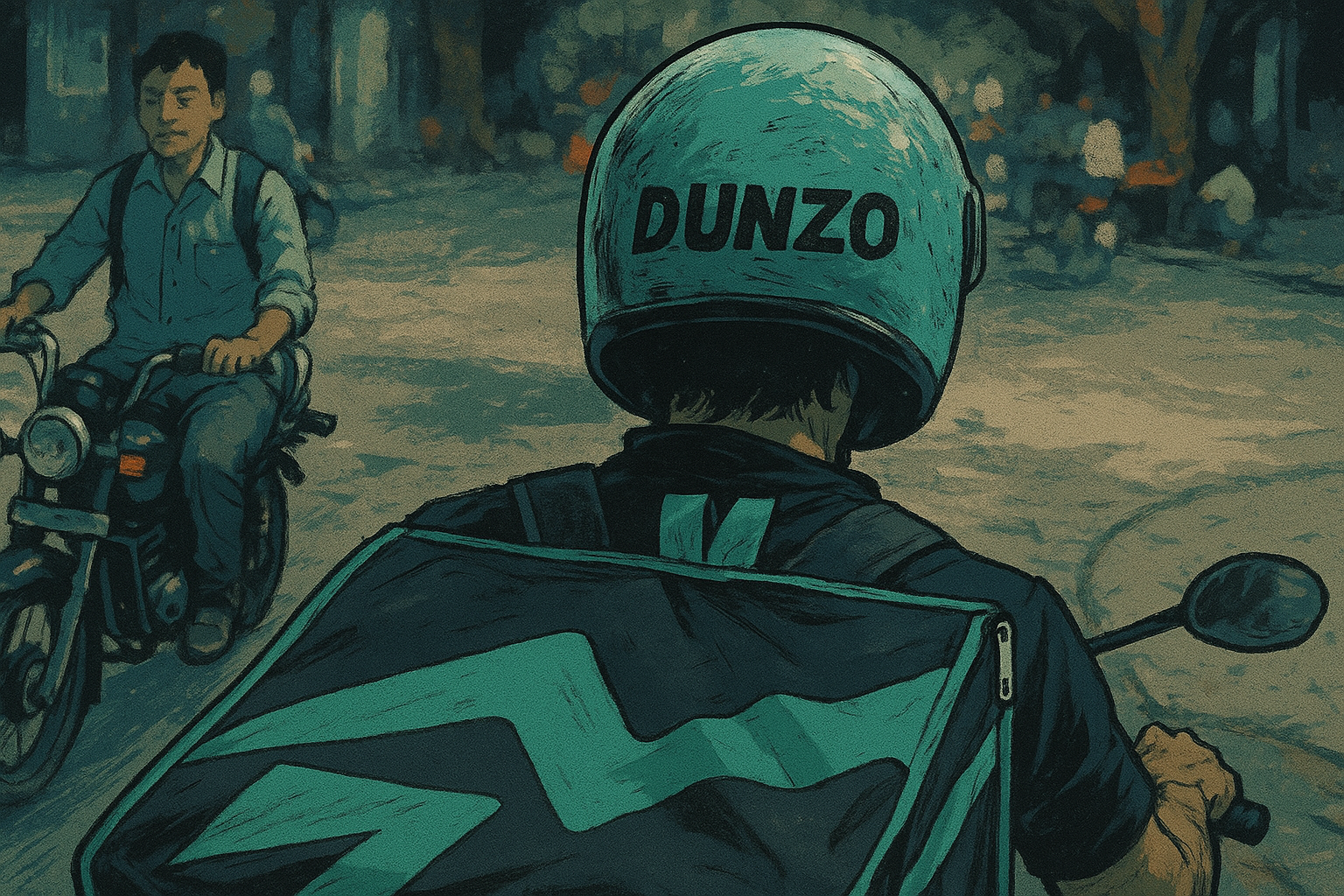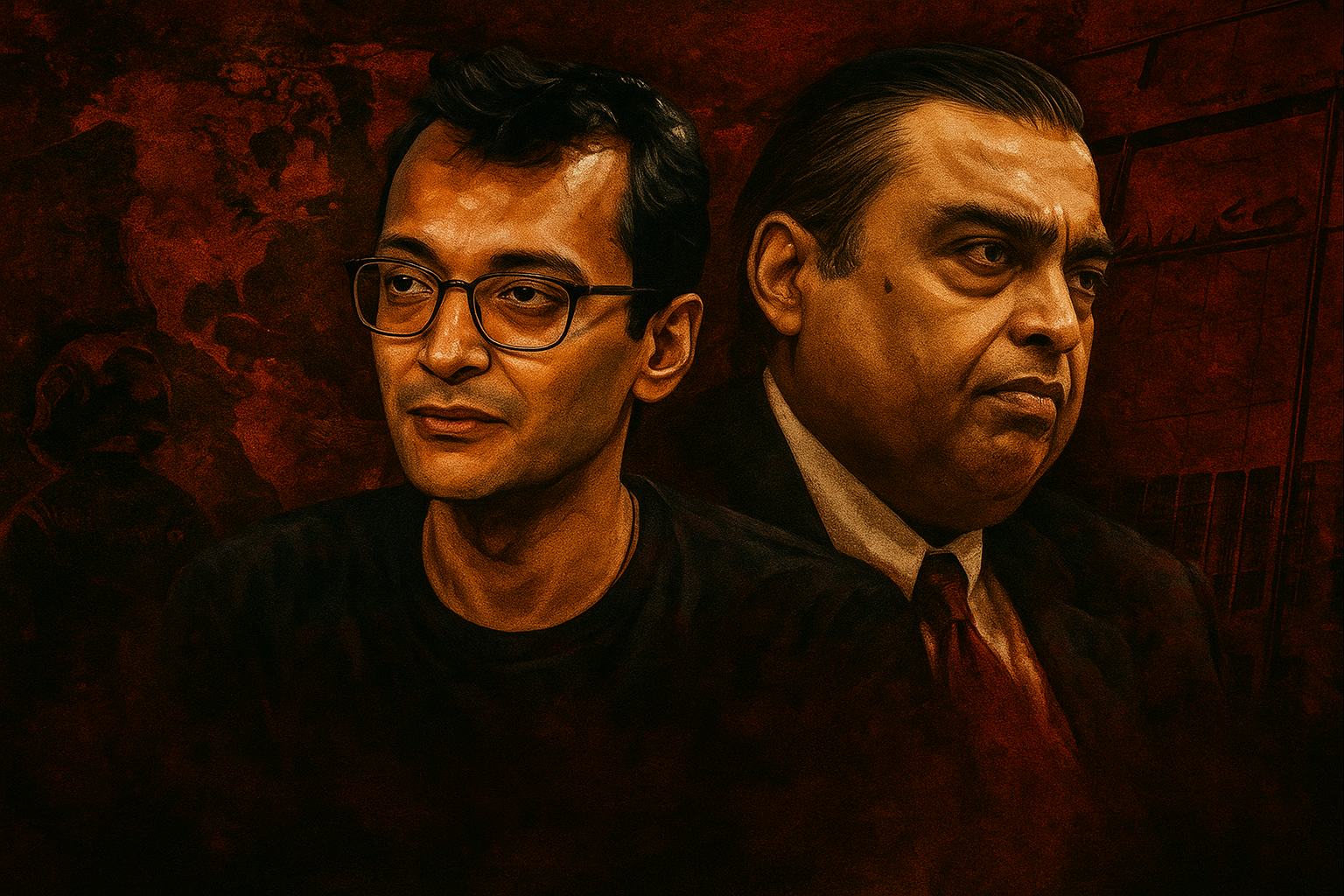Remember this:
When you’re building a startup, Blitzscaling (scaling too fast and chasing market dominance at the cost of profits) can either crown you as the market leader, or completely wipe you out from the market.
It’s a gamble. A bet taken collectively by founders, investors, and the board, hoping that burning money today will buy them tomorrow’s monopoly.
Now you might be wondering, what’s my point?
Well, here’s the story.
A company backed by Google and Reliance.
A company that pioneered the hyperlocal delivery space.
A company that once raised a staggering ₹2000 crore ($240M) in a single round.
A company that had the potential to completely change how India consumes and delivers.
And yet, today, that very company… ceases to exist.
So what went wrong?
Let’s rewind to the rise (and fall) of Dunzo.
And don’t miss the “speculations” section at the end. 👀
The Dunzo Dream: What Made It Special
Dunzo was started by Kabeer Biswas in 2014 in Bengaluru. Before Dunzo, Kabeer had already built and sold a startup called Hoppr (acquired by Hike Messenger). Soon after, Ankur Agarwal, Dalvir Suri, and Mukund Jha joined as co-founders.
At its core, Dunzo’s mission was simple: be the logistics partner of the city.
Forgot your documents at home while heading to the office? Dunzo it.
Want to send a birthday gift across town? Dunzo it.
Need medicines or groceries? Dunzo it.
And the crazy part is, they didn’t even have an app or website in the beginning.
Dunzo was running entirely on WhatsApp.
In those early days, Kabeer himself was the delivery boy, starting in the morning and running orders till 1 AM. That’s how scrappy it was.
By 2016, they launched their app. And suddenly, it exploded. Bengaluru was hooked.
There was no Instamart. No Blinkit. No Zepto.
If you needed something, you’d just say one thing:
“Dunzo karle.”
That’s how deeply it had entered the city’s culture.

The Problem With Concierge Delivery
Here’s the turning point.
Dunzo was initially in the concierge delivery space
Their motto: Deliver anything, anytime.
Sounds great, right? But here’s the problem.
Let’s say you forget your charger in the office, 25 km away. You Dunzo it. Cool.
But how often will you forget your charger? Once? Twice a year?
That means low repeatability.
And for a business, low repeatability is poison. Investors can’t project growth. The company can’t allocate funds properly. Future looks blurry.
Then comes operational cost.
For that one charger, a delivery guy has to ride 25 km. That’s fuel, time, effort.
If Dunzo charges you too much, you won’t pay.
If they charge too little, they burn money.
Lose-lose situation.
And the third problem? Randomness.
Orders weren’t consistent. Some days you get plenty, some days nothing.
So resources like delivery partners sat idle.
Now contrast this with DMart:
- People buy groceries every month → High repeat rate.
- Bulk stocking in one location → Low operational cost.
- Predictable demand → Efficient resource allocation.
That’s why DMart is a profit machine.
And this is exactly why Dunzo had to pivot away from the concierge model.
They kept the operations of concierge running, but it wasn’t seen as the main business model.
The Hyperlocal Aggregator Model:
Dunzo pivoted from concierge delivery to hyperlocal delivery.
This wasn’t quick commerce yet, but it laid the foundation for what quick commerce would later become.
And then something big happened.
In 2017, Google invested $12 million in Dunzo, making it the first Indian startup backed by Google.
So what’s the hyperlocal aggregator model?
Dunzo partnered with local shops like kiranas, stationeries, clothing shops…
Customer places an order → delivery partner goes to the nearest partner shop → picks the item → delivers it.
Simple. Brilliant. Scalable.
No inventory, no warehouses, no maintenance staff. Just empower local shops while Dunzo manages discovery and delivery.
But it had flaws.
- Inventory mismatch: Kiranas in India don’t track inventory in real time. If you ordered “Dove shampoo” and the shop didn’t have it, the order failed. Customer dissatisfaction.
- Low ticket size: If tomatoes cost ₹35 and delivery is ₹40, would you order? Probably not. Unless it’s urgent. But if the order is ₹300, a ₹40 fee feels okay.
So Dunzo burned a lot of cash partnering with brands and offering discounts to push up order sizes.
Then COVID hit. And ironically, it was the best thing that ever happened to Dunzo.
With people stuck at home, Dunzo became a lifeline. Groceries, medicines, essentials. At its peak, Dunzo was handling nearly 1 lakh orders a day.
But just as Dunzo was peaking, a storm was brewing.
The Rise of Quick Commerce
By 2020, quick commerce emerged. By 2021, it matured.
Zepto entered with a bold promise: delivery in 10 minutes.
Swiggy launched Instamart.
Zomato acquired Grofers and rebranded it as Blinkit.
And they all had one major advantage over Dunzo: inventory control.
How?
They built dark stores. Mini warehouses in each locality. Customers could see product availability in real time. No stockouts, no disappointments.
This changed the game.
The Breaking Point: Where Things Started Falling Apart
People slowly started choosing Zepto, Blinkit, and Instamart over Dunzo. These platforms were delivering faster, offering heavy discounts, and ensuring the right products reached customers.
This is when Dunzo decided to pivot from the hyperlocal aggregator model to Quick Commerce.
In 2021, Dunzo launched Dunzo Daily, a quick-commerce platform promising deliveries in just 19 minutes.
But here’s the catch: they didn’t shut down their concierge and hyperlocal delivery services. Instead, they added quick commerce as an additional layer.
They began burning heavily on dark stores, marketing, partnerships, and discounts.
Then, in 2022, something big happened.
Reliance invested a whopping ₹1,645 crores ($240 million) in Dunzo, acquiring a 25.8% stake, giving them VETO power.
With this, Reliance could now influence and control key company decisions.
The Identity Crisis
As Dunzo operated across three business models, people were confused about what it really stood for.
- Was it a courier service?
- A marketplace?
- Or a 19-minute grocery delivery app?
This lack of clarity diluted Dunzo’s identity. Realizing the mistake, Dunzo shut down the other two models in 2022 and focused entirely on Dunzo Daily.
But by then, Zepto, Blinkit, and Instamart had already captured most of the market. Dunzo had arrived too late.
Blitzscaling:
Quick commerce was a battlefield where every competitor was blitzscaling.
- Blinkit was backed by Zomato
- Instamart by Swiggy
- Zepto kept raising large rounds regularly
Dunzo wasn’t an outsider either, it had the backing of Google, Reliance, Lightbox, Lightrock, and Alteria Capital.
The problem was: to survive in quick commerce, Dunzo had to match the pace of its competitors.
So, it blitzscaled.
The Result?
In FY22, Dunzo reported ₹464 crore in losses with just ₹54 crore in revenue.
The Loss of Investor Confidence:
Even after the FY22 losses, investors might have continued backing Dunzo. But FY23 changed everything.
In FY23, Dunzo reported ₹1,801 crore in losses on a revenue of ₹226 crore.
The burn had gone off the charts.
At this point, investors realized recovery was almost impossible. Dunzo’s growth trajectory wasn’t convincing, it was like sailing endlessly in the ocean, hoping to find land.
So Reliance and others wrote off their investments, a signal that the invested money wouldn’t come back.
You might ask: If Reliance already put in ₹1,645 crore, why not add ₹1,000 crore more and save it?
It doesn’t work that way. Yes, Reliance has deep pockets. But pouring more money into a startup without a clear path is worse. Losing ₹1,600 crore is better than losing ₹2,600 crore.
Besides, Reliance already had JioMart, serving a similar market with a different model.
- Quick-commerce players (Zepto, Instamart, Blinkit) focus on small-ticket orders like milk, biscuits, veggies.
- JioMart focuses on large baskets like atta, rice, soaps, at lower prices, fulfilled from big warehouses (not dark stores) with 1–2 day delivery.
For Reliance, doubling down on JioMart made more sense than saving Dunzo.
And they weren’t wrong. By FY24, digital/new commerce (incl. JioMart) contributed ~19% of Reliance Retail’s revenue.
The Crash Down:
Co-founders began to exit:
- Dalvir Suri (led the B2B arm) resigned.
- Mukund Jha (CTO) exited.
That left Kabeer Biswas alone.
He stayed hopeful, but not for long.
Investors slowly exited. Google, Reliance, and others wrote off their stakes.
Kabeer eventually left and moved to Flipkart Minutes. Employee salaries went unpaid for almost 18 months, and many pursued legal action against the company and Kabeer.
Finally, in 2025, Dunzo shut down its operations.
The end of India’s quick-delivery pioneer.
Lessons from Dunzo’s Failure:
- Aggregator models struggle without inventory control.
- Don’t be everything to everyone. Multiple models dilute brand identity.
- Blitzscaling without profitability is a ticking time bomb.
- Don’t scale under market pressure. Define a mission, build a strategy, find your audience, serve them deeply.
- Do an end-to-end market study before trying to dig in a gold rush.
- Investor alignment is crucial. Your mission must match their interests.
- Execution > Idea. Zepto, Instamart, Blinkit out-executed Dunzo.

Speculations:
These are not my views but speculations gathered from reports and industry chatter.
Everyone was shocked when Reliance invested $240 million into Dunzo, a direct competitor of JioMart.
Some say Reliance’s real play was to study Dunzo from the inside, to understand hyperlocal market sentiment and customer behaviour, which could later fuel JioMart’s growth.
Others believe Reliance wanted Dunzo’s data, its tech talent, and most importantly, its 40,000-strong delivery fleet to supercharge JioMart’s last-mile operations.
A few experts argue that instead of buying Dunzo at a bloated valuation, Reliance took the smarter route, invest, gain veto rights, and indirectly control Dunzo’s decisions. This allegedly stalled Dunzo’s independence and choked its growth.
Reports also claim that Flipkart showed interest in acquiring Dunzo in 2024, but Reliance’s veto blocked the move. Many in the market expected Reliance to eventually absorb Dunzo, given it was the largest backer, but mounting liabilities and cash burn seem to have stalled any big acquisition.
Conclusion:
Today, Zepto, Instamart, Blinkit dominate quick commerce. Porter and Swiggy Genie handle courier runs. JioMart and DMart are levelling up in hyperlocal delivery.
So, Pick one problem. Solve it deeply. Don’t drift just to pivot.
Dunzo didn’t fail because the idea was wrong.
It failed because execution lost focus.
thehustleweek.com is here to remind you every week that you’re not alone on this journey. Don’t waste another year stuck in imagination; start taking action today. Each week, theHustleWeek aims to unlock your potential by providing valuable insights that inspire and empower you to think differently.
As a community of hustlers, theHustleWeek aims to positively impact your life. If you found this article useful, please share it and leave your thoughts in the comments section. Your feedback encourages us to create more curated content. Feel free to explore our other blogs as well.





